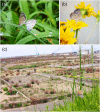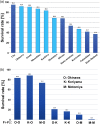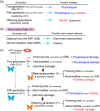Ingestional and transgenerational effects of the Fukushima nuclear accident on the pale grass blue butterfly
- PMID: 26661851
- PMCID: PMC4732531
- DOI: 10.1093/jrr/rrv068
Ingestional and transgenerational effects of the Fukushima nuclear accident on the pale grass blue butterfly
Abstract
One important public concern in Japan is the potential health effects on animals and humans that live in the Tohoku-Kanto districts associated with the ingestion of foods contaminated with artificial radionuclides from the collapsed Fukushima Dai-ichi Nuclear Power Plant. Additionally, transgenerational or heritable effects of radiation exposure are also important public concerns because these effects could cause long-term changes in animal and human populations. Here, we concisely review our findings and implications related to the ingestional and transgenerational effects of radiation exposure on the pale grass blue butterfly, Zizeeria maha, which coexists with humans. The butterfly larval ingestion of contaminated leaves found in areas of human habitation, even at low doses, resulted in morphological abnormalities and death for some individuals, whereas other individuals were not affected, at least morphologically. This variable sensitivity serves as a basis for the adaptive evolution of radiation resistance. The distribution of abnormality and mortality rates from low to high doses fits well with a Weibull function model or a power function model. The offspring generated by morphologically normal individuals that consumed contaminated leaves exhibited high mortality rates when fed contaminated leaves; importantly, low mortality rates were restored when they were fed non-contaminated leaves. Our field monitoring over 3 years (2011-2013) indicated that abnormality and mortality rates peaked primarily in the fall of 2011 and decreased afterwards to normal levels. These findings indicate high impacts of early exposure and transgenerationally accumulated radiation effects over a specific period; however, the population regained normality relatively quickly after ∼15 generations within 3 years.
Keywords: Fukushima nuclear accident; adaptive evolution; ingestional effect; internal exposure; natural selection; pale grass blue butterfly; radiation resistance; radiation sensitivity; transgenerational effect.
© The Author 2015. Published by Oxford University Press on behalf of The Japan Radiation Research Society and Japanese Society for Radiation Oncology.
Figures






Similar articles
-
Transgenerational effects of historic radiation dose in pale grass blue butterflies around Fukushima following the Fukushima Dai-ichi Nuclear Power Plant meltdown accident.Environ Res. 2019 Jan;168:230-240. doi: 10.1016/j.envres.2018.09.039. Epub 2018 Oct 1. Environ Res. 2019. PMID: 30321736
-
Robustness and Radiation Resistance of the Pale Grass Blue Butterfly from Radioactively Contaminated Areas: A Possible Case of Adaptive Evolution.J Hered. 2018 Feb 14;109(2):188-198. doi: 10.1093/jhered/esx012. J Hered. 2018. PMID: 28199653
-
Spatiotemporal abnormality dynamics of the pale grass blue butterfly: three years of monitoring (2011-2013) after the Fukushima nuclear accident.BMC Evol Biol. 2015 Feb 10;15:15. doi: 10.1186/s12862-015-0297-1. BMC Evol Biol. 2015. PMID: 25888050 Free PMC article.
-
Risk of thyroid cancer after the Fukushima nuclear power plant accident.Respir Investig. 2013 Sep;51(3):128-33. doi: 10.1016/j.resinv.2013.05.007. Epub 2013 Jul 31. Respir Investig. 2013. PMID: 23978638 Review.
-
Comparison of the Chernobyl and Fukushima nuclear accidents: a review of the environmental impacts.Sci Total Environ. 2014 Feb 1;470-471:800-17. doi: 10.1016/j.scitotenv.2013.10.029. Epub 2013 Nov 2. Sci Total Environ. 2014. PMID: 24189103 Review.
Cited by
-
Dispersibility of the Pale Grass Blue Butterfly Zizeeria maha (Lepidoptera: Lycaenidae) Revealed by One-Individual Tracking in the Field: Quantitative Comparisons between Subspecies and between Sexes.Insects. 2020 Feb 14;11(2):122. doi: 10.3390/insects11020122. Insects. 2020. PMID: 32074952 Free PMC article.
-
The Plastic Larval Body Color of the Pale Grass Blue Butterfly Zizeeria maha (Lepidoptera: Lycaenidae) in Response to the Host Plant Color: The Maternal Effect on Crypsis.Insects. 2023 Feb 17;14(2):202. doi: 10.3390/insects14020202. Insects. 2023. PMID: 36835771 Free PMC article.
-
Metabolomic Response of the Creeping Wood Sorrel Oxalis corniculata to Low-Dose Radiation Exposure from Fukushima's Contaminated Soil.Life (Basel). 2021 Sep 20;11(9):990. doi: 10.3390/life11090990. Life (Basel). 2021. PMID: 34575139 Free PMC article.
-
Overwintering States of the Pale Grass Blue Butterfly Zizeeria maha (Lepidoptera: Lycaenidae) at the Time of the Fukushima Nuclear Accident in March 2011.Insects. 2019 Nov 4;10(11):389. doi: 10.3390/insects10110389. Insects. 2019. PMID: 31690046 Free PMC article.
-
Soil Microbes and Plant-Associated Microbes in Response to Radioactive Pollution May Indirectly Affect Plants and Insect Herbivores: Evidence for Indirect Field Effects from Chernobyl and Fukushima.Microorganisms. 2024 Feb 10;12(2):364. doi: 10.3390/microorganisms12020364. Microorganisms. 2024. PMID: 38399767 Free PMC article. Review.
References
-
- Gibson BES, Eden OB, Barrett A, et al. Leukemia in young children in Scotland. Lancet 1988;2:630. - PubMed
-
- Petridou E, Trichopoulos N, Dessypris N, et al. Infant leukemia after in utero exposure to a radiation from Chernobyl. Nature 1996;382:352–3. - PubMed
-
- Kaletsch U, Michaelis J, Burkart W, et al. Infant leukemia after the Chernobyl accident. Nature 1997;387:246. - PubMed
-
- Ivanov E, Tolochko GV, Shuvaeva LP. Infant leukemia in Belarus after the Chernobyl accident. Radiat Environ Biophys 1998;37:53–5. - PubMed
-
- Busby C, Cato M. Increases in leukemia in infants in Wales and Scotland following Chernobyl. Energy Environ 2000;11:127–37.
Publication types
MeSH terms
LinkOut - more resources
Full Text Sources
Other Literature Sources

